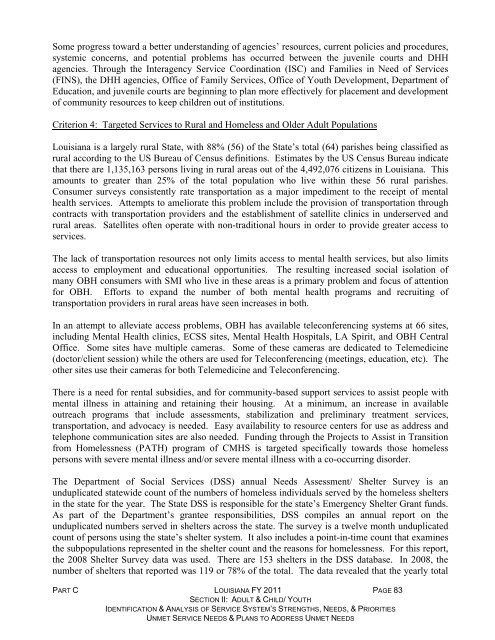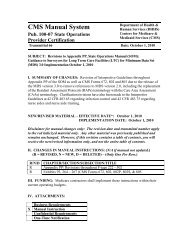LOUISIANA Community Mental Health Services Block Grant ...
LOUISIANA Community Mental Health Services Block Grant ...
LOUISIANA Community Mental Health Services Block Grant ...
Create successful ePaper yourself
Turn your PDF publications into a flip-book with our unique Google optimized e-Paper software.
Some progress toward a better understanding of agencies‟ resources, current policies and procedures,<br />
systemic concerns, and potential problems has occurred between the juvenile courts and DHH<br />
agencies. Through the Interagency Service Coordination (ISC) and Families in Need of <strong>Services</strong><br />
(FINS), the DHH agencies, Office of Family <strong>Services</strong>, Office of Youth Development, Department of<br />
Education, and juvenile courts are beginning to plan more effectively for placement and development<br />
of community resources to keep children out of institutions.<br />
Criterion 4: Targeted <strong>Services</strong> to Rural and Homeless and Older Adult Populations<br />
Louisiana is a largely rural State, with 88% (56) of the State‟s total (64) parishes being classified as<br />
rural according to the US Bureau of Census definitions. Estimates by the US Census Bureau indicate<br />
that there are 1,135,163 persons living in rural areas out of the 4,492,076 citizens in Louisiana. This<br />
amounts to greater than 25% of the total population who live within these 56 rural parishes.<br />
Consumer surveys consistently rate transportation as a major impediment to the receipt of mental<br />
health services. Attempts to ameliorate this problem include the provision of transportation through<br />
contracts with transportation providers and the establishment of satellite clinics in underserved and<br />
rural areas. Satellites often operate with non-traditional hours in order to provide greater access to<br />
services.<br />
The lack of transportation resources not only limits access to mental health services, but also limits<br />
access to employment and educational opportunities. The resulting increased social isolation of<br />
many OBH consumers with SMI who live in these areas is a primary problem and focus of attention<br />
for OBH. Efforts to expand the number of both mental health programs and recruiting of<br />
transportation providers in rural areas have seen increases in both.<br />
In an attempt to alleviate access problems, OBH has available teleconferencing systems at 66 sites,<br />
including <strong>Mental</strong> <strong>Health</strong> clinics, ECSS sites, <strong>Mental</strong> <strong>Health</strong> Hospitals, LA Spirit, and OBH Central<br />
Office. Some sites have multiple cameras. Some of these cameras are dedicated to Telemedicine<br />
(doctor/client session) while the others are used for Teleconferencing (meetings, education, etc). The<br />
other sites use their cameras for both Telemedicine and Teleconferencing.<br />
There is a need for rental subsidies, and for community-based support services to assist people with<br />
mental illness in attaining and retaining their housing. At a minimum, an increase in available<br />
outreach programs that include assessments, stabilization and preliminary treatment services,<br />
transportation, and advocacy is needed. Easy availability to resource centers for use as address and<br />
telephone communication sites are also needed. Funding through the Projects to Assist in Transition<br />
from Homelessness (PATH) program of CMHS is targeted specifically towards those homeless<br />
persons with severe mental illness and/or severe mental illness with a co-occurring disorder.<br />
The Department of Social <strong>Services</strong> (DSS) annual Needs Assessment/ Shelter Survey is an<br />
unduplicated statewide count of the numbers of homeless individuals served by the homeless shelters<br />
in the state for the year. The State DSS is responsible for the state‟s Emergency Shelter <strong>Grant</strong> funds.<br />
As part of the Department‟s grantee responsibilities, DSS compiles an annual report on the<br />
unduplicated numbers served in shelters across the state. The survey is a twelve month unduplicated<br />
count of persons using the state‟s shelter system. It also includes a point-in-time count that examines<br />
the subpopulations represented in the shelter count and the reasons for homelessness. For this report,<br />
the 2008 Shelter Survey data was used. There are 153 shelters in the DSS database. In 2008, the<br />
number of shelters that reported was 119 or 78% of the total. The data revealed that the yearly total<br />
PART C <strong>LOUISIANA</strong> FY 2011 PAGE 83<br />
SECTION II: ADULT & CHILD/ YOUTH<br />
IDENTIFICATION & ANALYSIS OF SERVICE SYSTEM’S STRENGTHS, NEEDS, & PRIORITIES<br />
UNMET SERVICE NEEDS & PLANS TO ADDRESS UNMET NEEDS
















